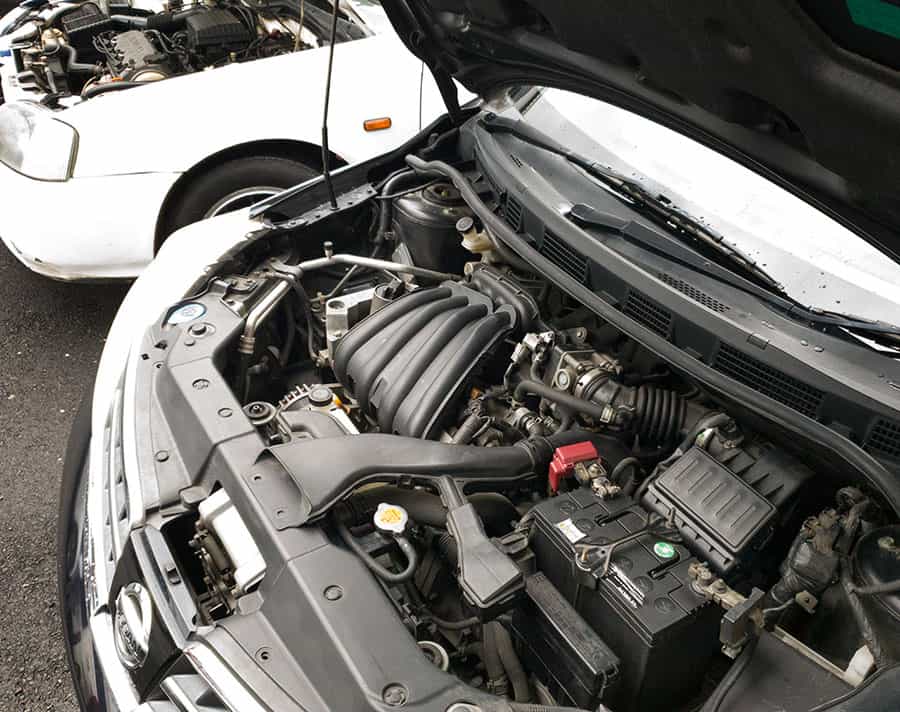
Above: Hoods up, these candidates await the inspector’s approval at a local vehicle inspection yard. I cleaned the engine of the one in the foreground by hand with a wet microfiber cloth. Photo by Mark Lyndersay.
BitDepth#1181 for January 24, 2018
Last week, I had two vehicles inspected.
It cost me $3,400, 19 working hours and several bruised knuckles. Still, it was cheaper than the potential fine of $5,000 for not going through the process.
From what I’ve seen happening in inspection yards, I got off cheap and easy.
Knowing little about either cars or the inspection process, I sought the advice of a mechanic to evaluate the vehicles in a pre-check.
It’s a step I recommend to anyone but the most auto-savvy of car owners before an inspection.
I saw vehicles that had no business in an inspection yard. Tyres that even to my untrained eye were bald, cracked rear-view mirrors, shaky front-ends and more.
For one, you will probably lose your entire $300 inspection payment for something easily rectified.
Another good reason is that for the foreseeable future, you’ll be joining a long line, even if you get there at dawn, to even get into an inspection yard.
There simply aren’t enough of these locations to service the massive number of vehicles on the roads that are eligible, by virtue of their age, for this evaluation.
Economist Dr Dhanyshar Mahabir ran the numbers on the inspection process and believes that with 50 inspection stations open, it would take two years to clear the backlog of vehicles that need to be evaluated.
The popular auto forum TriniTuner has posted a list of 83 active inspection stations, an increase mandated by Minister of Works and Transport Rohan Sinanan, who must be aware of the volume of roll-on/roll-off vehicles imported into this country from Japan and presumably has done his own calculations.
Even with the increase in stations, it’s likely that all the cars that need to be inspected will be completed roughly when the first cars to be inspected in July 2018 must join the line again.
While the underlying reason for the inspection process is sound, particularly in a country with an unquenchable appetite for foreign used vehicles, most of which arrive here three to four-years-old, there are aspects of the procedures which are just odd.
Ageing clunkers should be at least road worthy, both for the sake of drivers and the general public and clearly the inspections are meant to take dangerous junkheaps off the roads.
It’s likely that all the cars that need to be inspected will be completed roughly when the first cars to be inspected in July 2018 must join the line again.
Having never owned a new car, I moved from an 19-year-old auto to a four-year-old one and the jump in technology was staggering.
All the problems I’ve had with the car have been related to the sensors that control virtually every aspect of the car, yet the inspection process seems to be interested in things like an underbody and engine wash, which expose sensitive electronics to water under high pressure.
My knuckles are still rubbed raw from carefully wiping down two engines with a wet microfiber cloth.
Most of the cars going in for inspection are sealed boxes of modular components that are more likely to be covered in road dust than engine grease, making all this internal washing more of an aesthetic exercise than a practical one except perhaps for heavy-duty truck or off-road vehicles that spend their working lives in mud.
The days of cars rusting from the minute they rolled out of the showroom are, mercifully, largely behind us now and an inspection that targets that as a problem seems to be enthusiastically obsolete.
The inspection procedure does not test the diagnostic ports available on vehicles made in the last ten years, which offer more information than a casual eyeballing of the car will reveal.
But that’s going to raise the inspection procedure to another level of skill and technical understanding that it probably isn’t ready for.
We are now firmly in an era of hybrid vehicles, and I’m not sure what happens when a Tesla rolls into an inspection yard for the first time and the inspector opens the hood to find an empty space.



Additionally, the Transport Division limits the station to 50 stickers and receipt books, hence 50 cars a day. They believe that more than that would be a sign of corruption and “no look” inspections. But what if a station just improved efficiency and manpower to get a heads up in the marketplace? It seems, once again, that the civil service is living many years behind the time, and subjecting private companies to public sector standards of inefficiency, as if the two were ever equals in the marketplace.